With health budgets flat-lining and demand for healthcare rising, the only way Europe can improve patient outcomes is by finding new ways to do things better. But who will champion innovation in cancer care and how? The European School of Oncology convened a Task Force to come up with some solutions.
 If reimbursement authorities in Europe decline to invest in innovative treatments, they not only deny patients access to treatments that could benefit them, but risk seriously slowing the pace of progress in the fight against cancer. So claims the pharmaceutical industry, increasingly frustrated at obstacles in the way of getting new products accepted for reimbursement and adopted into clinical practice.
If reimbursement authorities in Europe decline to invest in innovative treatments, they not only deny patients access to treatments that could benefit them, but risk seriously slowing the pace of progress in the fight against cancer. So claims the pharmaceutical industry, increasingly frustrated at obstacles in the way of getting new products accepted for reimbursement and adopted into clinical practice.
Cancer is not the only serious or widespread health problem that requires innovative solutions, retort the payers, and medical therapies are not the only way to improve outcomes. The cost of new cancer therapies is rising faster than any other class of medicine, without a commensurate increase in benefit. We cannot justify putting money into new cancer drugs if the money can be spent to greater effect elsewhere.
Both make valid points. In a future when health budgets will struggle to keep pace with rising demand, investing in new and better ways to care for patients – and decommissioning interventions of poor value – is the only hope of improving outcomes. But ensuring that limited funds are put to best possible use requires making good choices about innovations and evaluating their true worth as they are developed and rolled out across health services.
There is an important discussion to be had about how health systems can best combine value for money with the flexibility to foster innovations and evaluate what they can contribute. However, the pharmaceutical industry cannot have that dialogue alone. Everyone involved from early detection and diagnosis, through planning and implementing treatment and care, to rehabilitation should be involved.
To broaden this discussion, the European School of Oncology (ESO) initiated an Innovation Task Force, where experts in health economics and health technology assessment sit with patient advocates, clinical researchers, cancer nurses, and representatives from companies involved in developing cancer drugs and diagnostics to learn from one another about how innovation is promoted, funded, evaluated and brought into clinical use and to find points of consensus about how to improve the process.
Towards an innovation-friendly cancer care system
When the ESO Task Force met for the first time in full in October 2013, it started by defining what they were talking about. Innovations in cancer care, they agreed, must address real unmet need in a measurable and sustainable way, or offer a cheaper or faster way of providing equivalent benefit to a currently available alternative, thereby freeing up resources that can be reinvested. Products can be innovative, but so can techniques and ways of organising and delivering care. Their value is measured in terms of the overall benefit they bring to the lives of patients and the overall cost/savings to the health system and society.
Understanding the priority needs of different groups of cancer patients must be the starting point for any health system looking to improve outcomes through innovation, they agreed.
Step 1: Research unmet needs
Cancer patients need treatments that are accessible, effective, safe and give good quality of life. How well those needs are met, and where patients’ priorities lie, vary between cancers and change over time as successful innovation meets the most pressing needs.
Three decades ago, for instance, the priority in childhood cancer was improving survival. Today, when four out of five children with access to high-quality treatment survive, the priority is to reduce toxicity and particularly the long-term effects. This was not fully appreciated until a group of researchers at a US children’s hospital asked the right questions. Their study of more than 1700 survivors of childhood cancers, published in JAMA this year (vol 309, pp 2371–81), revealed that 98% had at least one chronic health condition, and that by age 45 about 80% had at least one life-threatening, serious, or disabling condition.
In breast cancer, by contrast, 25 years ago patients reported nausea and vomiting as their biggest problem. Today, research done by the New South Wales Cancer Council in Australia, for instance, records access to car parking as the most frequently mentioned issue.
This is not as silly as it may sound, says Paul Cornes, a clinical oncologist at the UK’s Bristol Oncology Centre, with a special interest in health economics. “You have a treatment [radiotherapy] that takes five or ten minutes, and needs to be done daily for many weeks, and it’s an imposition on people’s lives.” He points to a number of studies that have correlated acceptance of radiotherapy for breast cancer with the time it takes to commute to and from that treatment (e.g. Cancer Causes Control 17:851–856).
“It’s been done in different countries, and we know that the effect is also higher in winter, when travel is harder. So you can demonstrate that something people may laughingly dismiss, like car parks, has a real impact on patients.”
Health systems aspiring to get the best possible outcomes must do more to encourage systematic research into patients’ priorities across all cancer types, says Cornes, and use those findings to inform their decisions. When evaluating the option of delivering radiotherapy over a shorter period or using medical therapies that can be delivered orally, for instance, the impact on convenience to patients should be taken into account.
Step 2: Support an innovation culture
Encouraging all professions in the patient pathway to look for better ways to do things as a standard part of their work, was seen as the next step for building innovation into the system. Avoiding regulations that load unnecessary cost and bureaucracy onto even the most simple clinical studies was an obvious point here. As Matti Aapro, chair of the Task Force and Dean of the Multidisciplinary Oncology Institute in Genolier, Switzerland, commented, teams that want to try out potentially better ways of doing things, however innocuous, can quickly fall foul of the rules. “If you call it a study, regulators make your life a misery,” he said.
Improving the coordination and planning of trials was identified as important to reduce duplication, improve trial design and make it easier for patients to enrol. This is an issue that some European countries are already tackling, with national trials structures and networks. Giampaolo Tortora, chair of ESMO’s Translational Research Working Group commented that trials don’t always take into account the latest biological information and are often more concerned with showing statistical significance than meaningful clinical benefit. Kathy Oliver, a patient advocate who is Co-Director of the International Brain Tumour Alliance, said the latter problem could be avoided if trialists consulted patient groups at the design stage. “So often people consult patients when it’s already too late,” she said. “If you ask their views at the start, they can advise on whether what you are proposing corresponds to real need and how best to show that.”

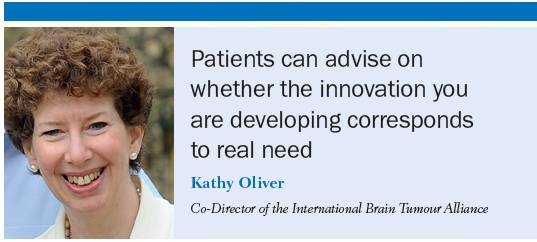 Taking a broad view of where innovation can come from was seen as an important element of developing an innovation culture. Few people anticipated that adding early palliative care to standard treatment in patients newly diagnosed with metastatic non-small-cell lung cancer would extend patients’ lives by more than two months, until the Temel study asked the question (NEJM 2010, 363:733–742).
Taking a broad view of where innovation can come from was seen as an important element of developing an innovation culture. Few people anticipated that adding early palliative care to standard treatment in patients newly diagnosed with metastatic non-small-cell lung cancer would extend patients’ lives by more than two months, until the Temel study asked the question (NEJM 2010, 363:733–742).
This unexpected finding raises questions about whether other opportunities are being missed to improve patient outcomes because of assumptions about the relative value contributed by the different professionals involved in caring for patients, including those working in a largely supportive role. As Birgitte Grube, past president of the European Oncology Nursing Society, pointed out, this in turn raises questions of whether the cuts in nursing posts that are happening across Europe might be based on assumptions rather than real evidence about the value nurses contribute to patient outcomes.
Peter Naredi, past president of the European Society of Surgical Oncology, pointed to another aspect of cancer care whose potential for improving outcomes is often overlooked: namely the way care is organised and delivered. Naredi knows about innovation: he pioneered new techniques in liver and pancreatic surgery and promoted the systematic uptake of new techniques in treating rectal cancer in his home country of Sweden. But at the Task Force, he singled out tumour boards and multidisciplinary teams as having the greatest potential to improve outcomes, because they ensure that treatment decisions are not made by the first specialist who sees the patient, without input from other professionals.
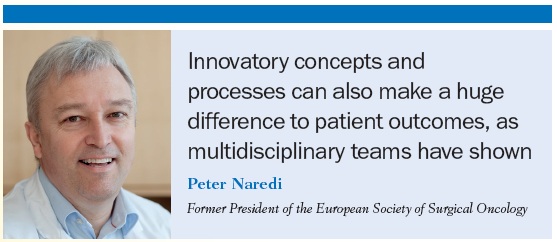 Working in multidisciplinary teams, it was noted, can also facilitate a patient-centred team approach to improving patient outcomes. Though as Grube, speaking from the cancer nursing perspective, pointed out, for this to work well, each profession in the multidisciplinary team must have knowledge and respect for others’ roles and responsibilities.
Working in multidisciplinary teams, it was noted, can also facilitate a patient-centred team approach to improving patient outcomes. Though as Grube, speaking from the cancer nursing perspective, pointed out, for this to work well, each profession in the multidisciplinary team must have knowledge and respect for others’ roles and responsibilities.
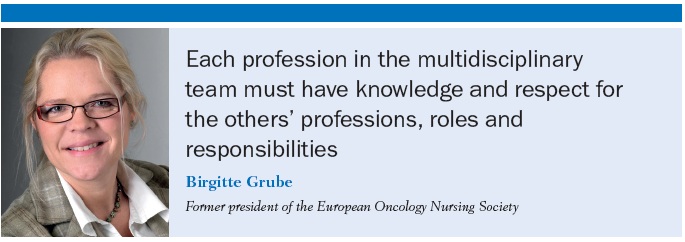 Cancer plans – which take a system-wide joined-up approach to assessing needs and delivering services – and registries – which provide information on outcomes – can be added to the list of concepts that have potential to yield substantial benefits for patients, as can guidelines to document and spread best practice, benchmarking, performance monitoring and audit.
Cancer plans – which take a system-wide joined-up approach to assessing needs and delivering services – and registries – which provide information on outcomes – can be added to the list of concepts that have potential to yield substantial benefits for patients, as can guidelines to document and spread best practice, benchmarking, performance monitoring and audit.
Step 3: Introduce early and evaluate effectively
Intuitively, it might make sense to evaluate first and introduce later, but the Task Force concluded that this is impractical in cancer because of the complex interplay between different contributions to patient care and the variety of costs and benefits to be taken into account. Innovations also typically evolve rather than emerging fully fledged, so deciding at what point in their evolution they should be evaluated is a matter of judgement. That is not to say that innovations should be introduced before they have been shown to be safe and effective – something that the Task Force noted is currently mandatory only for medical therapies. However, the overall value can only become apparent when the new product, technique or process becomes fully integrated within the patient pathway, used in a non-selected patient population in a real-life setting, where the benefits and costs to patients and the health system can be measured against the alternative it may replace.
As Aapro, chair of the Task Force, put it: “Something potentially innovative is introduced into a whole pathway, from diagnosis through decision making and all the different modalities of treatment through to palliative care, or rehabilitation and so on. Whether or not it actually turns out to be innovative depends on how it plays out within that whole context.”
How is the evidence gathered?
Evidence to show how innovative therapies do “play out” in real-life settings is increasingly being demanded by payers in addition to data required by the regulators for marketing approval. Pharmaceutical companies have accordingly started to invest in registries to gather the required information from centres where their new product is in use.
They are also trying to integrate the gathering of ‘value’ data into the development process to ensure it is available as soon as possible after a product gets regulatory approval. Joerg Adamczewski, Project Head for Oncology Development at Sanofi, said that an increasing willingness by payers to interact with manufacturers early in development to provide guidance is very welcome. “We hope this engagement will allow us to work with payers to develop a definition of value that incorporates unmet need, the level of scientific innovation, and the impact that the drug has on the lives of patients and caregivers,” he said.
 The problem is that getting Europe’s various decision makers to agree on similar measures of costs and benefits is turning out to be a major challenge.
The problem is that getting Europe’s various decision makers to agree on similar measures of costs and benefits is turning out to be a major challenge.
This has big implications for the practicalities of demonstrating to payers the value of an innovation, because every country – and sometimes each region or even individual hospitals – demand different sets of data relevant to their own needs.
Agreeing on the seriousness of toxic side-effects from a medical perspective is more straightforward than assessing the cost to a patient of diarrhoea, bloating, anxiety, or disruption to daily life. Though progress towards a common evaluation has been made, for instance with a variety of quality of life ‘instruments’ validated across many European countries, these are too blunt to capture the level of detail for assessing the added value of most innovations.
One innovative approach to gathering quality of life information, which is about to be piloted in conjunction with the UK national brain tumour registry, was mentioned by Kathy Oliver. It involves an online Brain Tumour Patient Information Portal, where patients can access their own clinical and pathological records, but can also contribute information (www.nbtr.nhs.uk/patientportal.html). “Patients can feed in information about side-effects and give feedback on what they think has been innovative about treatments. This is hopefully something that will be rolled out to other site-specific cancers in the future,” she said.
The impact on cost/savings of introducing an innovation will also play out differently, for instance, according to whether care is primarily delivered by doctors in a hospital setting, or greater use is made of specialist nurses in an outpatient or community setting, and according to the levels of sickness benefit, rights to social care and so on.
One suggested solution to reduce the proliferating demands for different types of data lies with greater coordination in the analysis of new health technologies across Europe.
The foundations for this have already been laid through EUnetHTA, a network of European health technology assessment (HTA) bodies, set up in 2009 with a mission to develop reliable, timely, transparent and transferable information to contribute to health technology assessments in European countries. Finn Kristensen, chair of EUnetHTA, freely admitted that it will never be to HTA what the centralised procedures of EMA are to drug regulation, as there are obstacles even at the level of national legislation to getting countries to work together in HTA as closely as in drug licensing. However, he felt that EUnetHTA is an underused resource that could play an important role in improving the way Europe evaluates innovation in health. “There is a lot more that we can still agree on about how we assess quality of evidence from a scientific point of view. It is now up to the cancer community to say to Member States: we have a problem, and you need to use this HTA network more!”
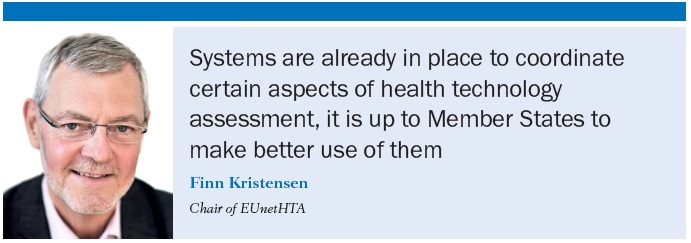 Greater investment in registries to gather real-life outcome data was also suggested as essential to improve capacity for evaluating the impact of innovations. There could be potential, for instance, for companies to collaborate more in running multi-sponsor registries for particular disease groups.
Greater investment in registries to gather real-life outcome data was also suggested as essential to improve capacity for evaluating the impact of innovations. There could be potential, for instance, for companies to collaborate more in running multi-sponsor registries for particular disease groups.
This is not just an issue for pharmaceutical companies, however, as Yolande Lievens, head of radiation oncology at Ghent University Hospital in Belgium, pointed out. She and her colleagues are currently running a registry to evaluate which patients benefit from being treated with stereotactic body radiotherapy, which uses advanced image guidance to pinpoint beams on the tumour. As this is more about techniques than equipment, manufacturers don’t have an incentive to cover the cost of gathering evidence. To avoid delaying patient access to these promising techniques until they are included in formal reimbursement schemes, the Belgian government has therefore agreed on provisional financing of the treatment and the registries for four years while further evidence is gathered and analysed. This programme is being run in collaboration with the Belgian health insurance and cancer registry.
Lievens suggests a more strategic approach to developing registries – involving collaboration between industry, the academic world and professional societies – will be key to developing Europe’s ability to evaluate and promote innovation.
When is the evidence gathered?
Given that innovation is a process that can take decades to mature, the question arises of when decisions are made. A decision made too early, before clinical researchers have time to learn how an innovation can best be integrated with other treatments and which patients derive the greatest value, could kill off something that would yield beneficial results. Wait too long and patients will be deprived of access to something that could benefit them.
Lievens said that this was a problem with the stereotactic radiotherapy techniques she is now evaluating in Belgium, because progress was incremental. “If you look back you can say that from cobalt to linacs was a very important change. Or when we started to use CT scans to plan conformal treatment, that marked an enormous change. But at the time it was insidious. It wasn’t obvious. It’s only years afterwards that you can look back and say that was really an innovation.”
One consequence, said Lievens, is that there is often a serious delay from the time the technology is developed at research centres to the point at which it is introduced and reimbursed in daily care. To ensure quicker patient access to new technologies, she suggests greater use of “coverage with evidence development” programmes like the one she is involved in for stereotactic body radiotherapy. Funding could come from government, industry or other sources, and should be made available to introduce the innovation into clinical practice – perhaps at selected cancer centres – at an early stage of technology development. “In return, providers to whom the new technology is made available, should commit themselves to generating cost and outcome data, necessary for well-timed economic evaluation and health technology assessment.”
 These sorts of approaches are beginning to be used more widely in some European countries. In Germany, for instance, under the 2011 Reform of the Market for Medicinal Products law (AMNOG), reimbursement of a new medical therapy is guaranteed at the manufacturer’s price for 12 months from the day it gets approved by the EMA. A cost-benefit evaluation of the therapy is then done by an umbrella body of health insurance funds, in collaboration with the HTA body IQWiG. The final reimbursement price is negotiated at the end of the 12 months, according to the evidence on whether or not the therapy adds value in some way (and for which patients) compared to the currently used alternative.
These sorts of approaches are beginning to be used more widely in some European countries. In Germany, for instance, under the 2011 Reform of the Market for Medicinal Products law (AMNOG), reimbursement of a new medical therapy is guaranteed at the manufacturer’s price for 12 months from the day it gets approved by the EMA. A cost-benefit evaluation of the therapy is then done by an umbrella body of health insurance funds, in collaboration with the HTA body IQWiG. The final reimbursement price is negotiated at the end of the 12 months, according to the evidence on whether or not the therapy adds value in some way (and for which patients) compared to the currently used alternative.
The UK, meanwhile, has launched a Commissioning through Evaluation programme, that will allow certain treatments that show “significant promise in terms of improving quality of life or potentially survival, but [are] not accessible through a formal research trial,” to be funded in a small number of participating centres, and within an explicit evaluation programme.
Who decides, and how?
Promoting innovation that benefits patients – and cutting spending on things that add no value – is about making informed judgements from a system-wide perspective. In practice, as the Task Force heard from many participants, this is not always the way decisions are taken.
Lack of understanding of the real issues was seen as a big problem, particularly when decisions are made by doctors with no background in health technology assessment and health economics. “Typically decisions are often made on budget impact rather than clinical effectiveness or cost-benefit,” said Daniel Schneider, Senior Director EMEA [Europe Middle East and Africa] Sales and Marketing at the diagnostics company, Genomic Health. This is a particular issue for innovation in diagnostics, he added, because “it is the physicians who drive the process, so in many countries we are reliant on the physicians to apply [for reimbursement] for us.”
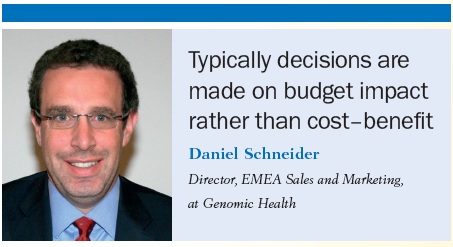 Statistics from France, on the cost–benefit of screening lung cancer patients for the EGFR mutation illustrate the dangers of focusing on costs alone – studies have shown that while the health system spends around €1.7 million a year on the diagnostic procedure, €69 million is saved by ensuring that patients without mutated EGFR are not treated with a tyrosine kinase inhibitor.
Statistics from France, on the cost–benefit of screening lung cancer patients for the EGFR mutation illustrate the dangers of focusing on costs alone – studies have shown that while the health system spends around €1.7 million a year on the diagnostic procedure, €69 million is saved by ensuring that patients without mutated EGFR are not treated with a tyrosine kinase inhibitor.
The Task Force also heard how sometimes even the more established HTA bodies fail to grasp, for instance, the way statistical significance works. “They say ‘We will look at the 25% of patients who interest us from this trial.’ But when it is only 25%, the effect is no longer statistically significant, as the number of events becomes too small! So they conclude ‘You have not demonstrated anything relevant from the trial.’”
Lack of understanding about cancer among many decision makers was felt to be an equally serious problem. Progress over past decades has tended to result from incremental advances in every part of the treatment pathway, as clinicians learn to combine them to greatest effect and in the right patients. People who are not familiar with this may be less inclined to give new products and processes the chance to prove themselves. People who are not familiar with cancer can also underestimate the difference seemingly “little things” can make to quality of life and/or adherence, or what a difference a few additional weeks of life can make to some people. They may adopt a more defeatist attitude; a greater tendency to assume that cancer is a ‘hopeless case’ and that investing in things that are not clearly ‘breakthroughs’ is a waste of resources.
Greater consistency and streamlining of decision making was also seen as an issue. Task Force chair Matti Aapro questioned whether treatments for other diseases have to fulfil the same stringent criteria as new drugs for cancer.
“We need to remember that cancer is part of wider health spending. We face demands to show increased survival which we can’t always meet. But are the evaluators using the same criteria for other areas?” Even within cancer, there are anomalies in the way decisions are taken, as Bengt Jönsson, a health economist from the Stockholm School of Economics, pointed out. “In Sweden we have one system for deciding on oral cancer drugs and another for deciding on infused drugs. We need more consistency in how we make decisions,” he said.
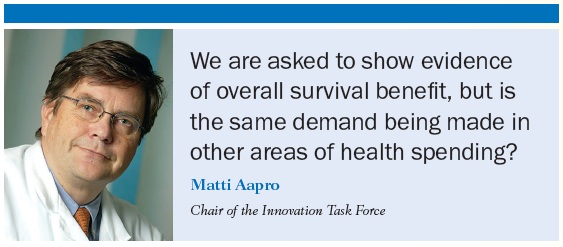 Centralising evaluation and decision making was strongly felt to result in a better quality of analysis, with decisions more likely to reflect the best interests of the health system or society as a whole, rather than being driven by a local perspective. Pere Gascón, head of the medical oncology department at the Hospital Clínic of Barcelona, gave as an example the way hospitals in Spain tend to weigh up the pros and cons of epoietin, used as an alternative to transfusion to treat anaemia. “Epoietin is expensive, but it’s about half the price of transfusion. However the government pays for transfusions, so it costs the hospital nothing. By comparison, any drug that can be used as an alternative is expensive,” he said. “Hospitals are on a fixed budget and they don’t want to think about the broader picture.”
Centralising evaluation and decision making was strongly felt to result in a better quality of analysis, with decisions more likely to reflect the best interests of the health system or society as a whole, rather than being driven by a local perspective. Pere Gascón, head of the medical oncology department at the Hospital Clínic of Barcelona, gave as an example the way hospitals in Spain tend to weigh up the pros and cons of epoietin, used as an alternative to transfusion to treat anaemia. “Epoietin is expensive, but it’s about half the price of transfusion. However the government pays for transfusions, so it costs the hospital nothing. By comparison, any drug that can be used as an alternative is expensive,” he said. “Hospitals are on a fixed budget and they don’t want to think about the broader picture.”
 Sectoral agendas can also trump broader health economic considerations when it comes to buying expensive high-tech equipment like DaVinci robotic surgery machines, said Naredi. There is no clear evidence to show that robotic surgery improves outcomes, he argued, “It’s probably just more fun for surgeons, or good for hospitals from a recruitment perspective.”
Sectoral agendas can also trump broader health economic considerations when it comes to buying expensive high-tech equipment like DaVinci robotic surgery machines, said Naredi. There is no clear evidence to show that robotic surgery improves outcomes, he argued, “It’s probably just more fun for surgeons, or good for hospitals from a recruitment perspective.”
Step 4: Out with the old, in with the new
Innovation won’t pay off until patients get access, so the next step is ensuring that all health professionals who care for cancer patients incorporate innovative products and practices into their daily practice quickly and effectively. This can be a challenge, the Task Force participants agreed, as health systems can be resistant to change. Changing the practice you were brought up to believe was the gold standard can feel tantamount to “being a traitor to ones training,” was one comment. Another phrase that came up was “ritualistic practice” – we do it this way because that’s how it’s always been done.
Implementing change is an area that the European Oncology Nursing Society pays great attention to in its own training courses, said Birgitte Grube. “It is important to choose an implementation strategy and acceptance at every level of the process, to make sure that innovative thinking is valid and has a real chance for success.”
At a national level, systems based on networks of specialist multidisciplinary teams, working to regularly updated national guidelines, were recognised as having an advantage when it comes to promoting rapid uptake of innovation. The ability to monitor uptake was also seen as important, but would require practitioners to co-operate with clinical registries – which record interventions as well as outcomes – or some other form of performance monitoring.
The role of patients in driving uptake should not be overlooked, said Kathy Oliver, who made a plea for advocates to be given support and encouragement, including access to relevant information, to facilitate lobbying for the latest improvements. “Patients often know about innovations before health professionals,” she said.
Paul Cornes, from the Bristol Oncology Centre, suggested that promoting uptake may be less of an issue where innovations are subject to more systematic and robust evaluation. “The argument for NICE [the UK’s HTA body] is that, although it might slow down the initial assessment, once they say ‘yes’, it does get taken up everywhere within 12 weeks.” Patients might benefit if surgery and radiotherapy were to come under the NICE remit, he argued, “because approval comes with budget and speedy uptake”.
 He cited total mesorectal excision, which has been shown to cut recurrence in rectal cancer from 25% to 10%, as an example. Much of the work to spread the technique, nationally as well as internationally, was done by one surgeon, Bill Heald, from a district hospital in Basingstoke, England. He earned the nickname “Saint Bill” for the personal effort he put in, over many years, often having to scrabble around for money. Might the uptake have been quicker if the procedure had gone through NICE for formal evaluation, Cornes asked?
He cited total mesorectal excision, which has been shown to cut recurrence in rectal cancer from 25% to 10%, as an example. Much of the work to spread the technique, nationally as well as internationally, was done by one surgeon, Bill Heald, from a district hospital in Basingstoke, England. He earned the nickname “Saint Bill” for the personal effort he put in, over many years, often having to scrabble around for money. Might the uptake have been quicker if the procedure had gone through NICE for formal evaluation, Cornes asked?
Conducting thorough evaluations also has the advantage of forcing a reassessment of existing practices, which could free up resources currently being wasted. Jönsson of the Stockholm School of Economics gave the example of a new drug for benign prostate hyperplasia, which the German payers initially argued was too expensive. “Then they noticed they spent millions of euros a year on herbal medicines which had no effect. So they were paying for undocumented herbal medicine, but didn’t want to pay for a drug with documented effectiveness.”
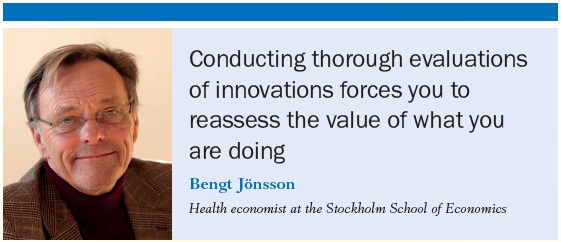 One question was whether European health systems would benefit from a more systematic approach to cutting wasteful spending, along the lines of ASCO’s Choosing Wisely Campaign, which annually highlights five categories of procedures or treatments that are not supported by available evidence.
One question was whether European health systems would benefit from a more systematic approach to cutting wasteful spending, along the lines of ASCO’s Choosing Wisely Campaign, which annually highlights five categories of procedures or treatments that are not supported by available evidence.
Something similar is currently under consideration in Italy, where the health ministry is exploring ways to introduce a requirement on clinicians to actively screen what they do to identify obsolescence.
Step 5: A vision and a will
Step 5 is the step needed to translate steps 1 to 4 from a paper exercise and well-intentioned words into action that can make Europe’s health systems work better for patients. This is the hard part, said Agnès Buzyn, who heads up France’s national cancer institute, and participated in the Task Force. Appointed by former President Nicolas Sarkozy, Buzyn has strategic responsibility for both research and delivery of care, which makes her uniquely well placed to promote innovation and foster its uptake. But while there is much France can teach other countries about integrating research and care agendas, Buzyn insists that no single country can sort out this problem alone.
“You need vision at a European level to champion innovation as a goal,” she said. The reason why pharmaceutical companies are dominating the innovation agenda is because of the complete absence of a strong vision and leadership championing a broad perspective of innovation on behalf of patients and citizens. “On the one side you have industry, on the other we are split into agencies, regulators and countries. We need to pull the agencies together, not at a national but at a European level.”
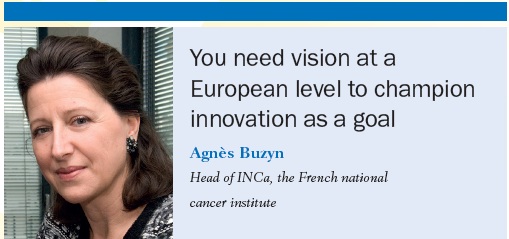 This, she adds, requires political will that is painfully lacking at present. “The problem with politicians now is the only contact they have with health is over scandals. Health systems are mostly geared against innovation, because their only interest is the safety agenda.”
This, she adds, requires political will that is painfully lacking at present. “The problem with politicians now is the only contact they have with health is over scandals. Health systems are mostly geared against innovation, because their only interest is the safety agenda.”
Finn Kristensen of EUnetHTA, suggested that a good start could be to expand the EU’s cancer research agenda to incorporate some of the system-level issues raised at the Task Force, by assembling a European consortium involving scientists from relevant research disciplines to put in for funding from the Horizon 2020 EU research budget. “Cancer people probably think traditionally about what kind of research you can make proposals on, which would be clinical research, which is of course important. But you can also look at an area, say cancer, and say we have some problems across Europe in getting systems to work better for patients and maybe encourage researchers to make a consortium to do research on that.” This was supported by Jönsson, the health economist, who pointed out that focusing on developing a more consistent approach to the way investment and spending decisions are taken would link to the EU agenda on transparency and accountability.
“The message that came out of the Innovation Task Force meeting,” said Cornes, “is that we spot innovation in treatment badly, we delay it coming through, we don’t fund it and we must learn how to do better.” Will oncologists be willing to step beyond their clinical responsibilities and get involved? We have to, said Cornes, who now spends half his time teaching health economics to oncologists. “We have more people to treat with more treatments but potentially less resources in the future. If we abrogate the responsibility to lead on that, inevitably we will be led by economists, administrators and politicians, and that would be a bad thing.”
20 STEPS TO PROMOTE INNOVATION
Focus on unmet need
- Invest in researching patient needs, in different cancers, with a view to developing a broad picture of patient priorities. Focus the research along the whole pathway of care, including how the care is organised, delivered and evaluated, looking at issues during diagnosis/treatment/care, but also after treatment.
- Seek patient input as early as possible in the innovation process.
Promote an innovation culture
- Develop a system-wide strategy for investment in innovation that fits needs. This requires a joined-up approach involving people responsible for developing and implementing cancer strategies/plans, those involved in developing innovation, and the payers who take decisions on reimbursement.
- Implement patient-centred multidisciplinary teams, where all professionals are treated with equal respect, and teams are expected to continuously pose the question: how can we do things better?
- Invest in the development and evaluation of innovation – costs should not be borne by individual hospitals or departments.
- Provide training for clinicians in cost-effectiveness evaluation.
- Provide strategic oversight of studies and trials to avoid duplication or unnecessary, poorly designed trials.
Ensure regulations governing trials at EU, national and hospital level are fit for purpose.
Evaluate effectively
- Institute clear and transparent processes for reimbursement decisions on innovations, and subject all innovations to cost-effectiveness analysis using consistent criteria.
- Allow more flexibility in reimbursement procedures so patients can get early access to innovation that might benefit them and evidence on value can be gathered in a real-life setting.
- Use the broadest criteria for measuring cost and value to the patient and society, use instruments that capture those costs and benefits effectively, and ensure that decision makers understand cancer issues as well as health economics.
- Make greater use of EUnetHTA to promote a coordinated approach to evaluating innovations.
- Centralise evaluations and decisions on reimbursement as far as possible – replicating processes at regional or hospital level wastes resources, leads to poorer quality decision making, and allows local interests to trump wider social interest.
- Invest in registries for gathering evidence in real-life settings. Aim for greater conformity in data gathering to enable fewer, larger studies.
- Incentivise data collection: clinical researchers/departments need funding to generate evidence on the cost-effectiveness of new techniques and procedures.
Out with the old, in with the new
- Invest in spreading innovation throughout clinical practice and monitor uptake.
Scrutinise every aspect of clinical practice – stop wasting resources on things that have no value. - Facilitate access to information by patient advocates – they are very effective at driving innovation uptake.
A vision and a will
- Expand the EU cancer research agenda to include exploring systems issues in how to foster and evaluate health innovation and promote speedy and widespread take up.
- Unite cancer agencies across Europe behind a pro-innovation agenda, and build political will to balance the safety agenda with actively championing innovation in cancer.



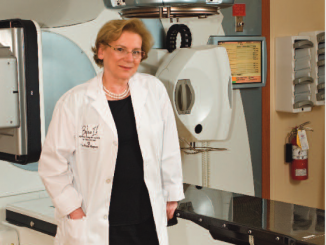
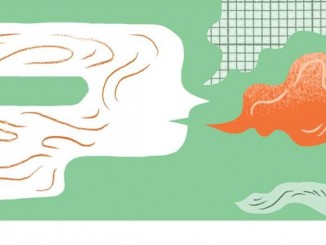

Leave a Reply